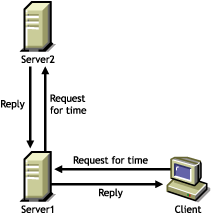3.1 Client-Server Mode
In this mode, the time consumer requests the time provider for the time and the time provider resplies back with the time, taking into account the time delays and other contingencies.
Figure 3-1 Client-Server Mode

The time provider might also be a time consumer to another time provider. This scenario is displayed in the next figure. In this case, the time provider (Server1) requests the time from its time provider (Server2) and, upon getting a reply, responds to the time consumer (Client).
Figure 3-2 Time Provider As a Time Consumer

You must synchronize the server prior to synchronizing the client. Therefore, it is important to configure the server in either of the following ways:
-
Self-synchronized: Here, the local clock is used as the time source and the server synchronizes with it. Add the following lines to the ntp.conf file (located in sys:\etc)
server 127.127.1.0
fudge server 127.127.1.0 stratum 3
-
As a client to another server: Here, the server is configured as a time consumer to another time provider. Add the following line in the ntp.conf file:
server IP_address_of_time_providerAfter you configure the server, you can configure the clients to use this server as a time provider. To do this, add the following lines to the ntp.conf file:
server IP_address_of_server
See Section 4.1, Manual Configuration for more information.